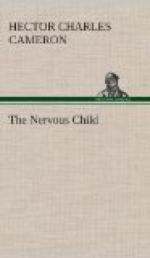MIGRAINE AND CYCLIC VOMITING
The aetiology of cyclic or periodic vomiting in childhood is not yet completely understood. We do not know how far it is dependent upon disturbance of the liver, and it is still disputed whether the acidosis which accompanies it is the cause or the result of the profuse vomiting. Into these difficult questions we need not at the moment enter. It is enough in the present connection to recognise that the great majority of children who suffer from cyclic vomiting are sensitive, excitable, and nervous, and that every one is agreed that the nervous system is intimately concerned in its causation.
A close association between cyclic vomiting in children and that form of periodic headache known as migraine has often been observed. It is sometimes found that one or both parents of a child with cyclic vomiting suffer habitually from migraine. In a few instances the one condition has been observed to be gradually replaced by the other, the child with cyclic vomiting becoming in adult life a sufferer from migraine. There is indeed much which is common to the two conditions. The periodic nature of the seizure, often following a time when the general health and vigour appear to have been at their optimum, the extreme prostration, and the comparatively sudden recovery are found in both. In the cyclic vomiting of children, it is true, little complaint is made of headache, the visual aura is absent, and the vomiting is invariably the most prominent symptom.
Cyclic vomiting seldom occurs before the fourth year. It is characterised by sudden profuse and persistent vomiting and by very great prostration. All food, it may be even water, is promptly rejected. The vomited matter is generally stained with bile; occasionally the violence of the vomiting causes haematemesis. In many cases the temperature is raised; sometimes it may be as high as 103 deg. F. The duration of an attack varies. In most cases it does not last longer than forty-eight hours. On the other hand, attacks lasting as long as a week are by no means unknown. Within a short time of the onset the urine may be found to contain acetone bodies, the breath may smell distinctly of acetone, and the child may become torpid and drowsy or agitated and restless. At times there may be exaggerated and deepened respiratory movements—the so-called air hunger. In many cases, however, otherwise characteristic, these more severe manifestations are absent or but little apparent. Recovery is usually rapid and complete. The child asks for food, which is retained. A fatal ending is very rare, though not unknown. The frequency of attacks is very various. Sometimes months or even years may elapse between successive seizures; in other cases a fortnightly or monthly rhythm establishes itself.




